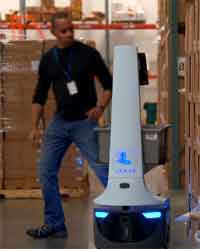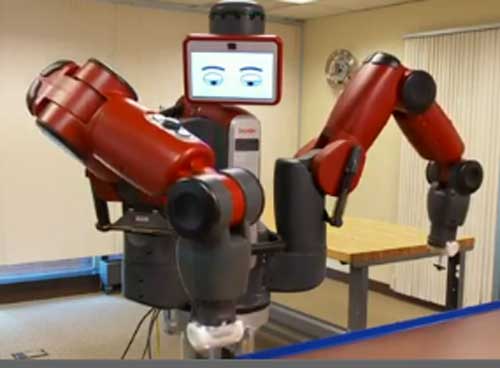As robotic technology continues to make incredible advances, worries about the impact on jobs are naturally growing.
This is certainly true relative to distribution, where such concepts as a "lights outs" warehouse bring to mind images of hundreds or even thousands of robots putting away inventory and picking products for customer orders with just a relative handful of humans around to ensure everything is operating well and to keep all the robots in service.
Supply Chain Digest Says... |
|
|
But perhaps that vision takes things too far. Maybe the right model is one with a good number of humans working in parallel – and in some cases side by side – with a new generation of DC robots. Maybe there are fewer employees than there would be without the robots, but there are still quite a few - in an era where it is getting increasingly tough to find enough DC workers out there as it is.
For example, in DCs where Amazon has deployed its Kiva System robots that deliver inventory to pickers, the hundreds or even thousands of the machines per DC have seemed to only place a relatively small dent in the in total number of employees an Amazon fulfillment center needs, as emphasized in Amazon's recently announced plans to hire as many as an amazing 50,000 DC workers in the US in the coming months
Another example of this co-operative human-robot model is the relative new system from Locus Robotics. Developed after 3PL Quiet Logistics was worried that its future with the Kiva robots it had deployed was in jeopardy after Amazon acquired Kiva in 2012, the Locus robots work hand-in-hand with humans to fulfill order.
Greatly simplified, it works like this: a Locus robot in effect meets an order picker at a location holding inventory for a customer order, typically of the ecommerce kind. The order picker selects the product and puts it onto a tote on the robot, confirming the pick on a tablet computer attached to the robot.
The robot then either heads to the packing area if the order is complete or to another location if there are more line items on the order, where it will meet up with another worker to pick that next item before it eventually moves on to packing.
Locus founder Bruce Welty told SCDigest a couple of years ago that there would normally be 6-7 robots to support one picker. That ratio can almost guarantee that there will be a robot waiting for the worker at a pick location, instead of the picker needing to wait for a robot to show up.
 DHL is using the Locus robots at a distribution facility in Memphis. In Europe, DHL is piloting what it calls "smart carts" which travel along with an order picker, know when to stop for the next pick, and then move to packing when the picks for a cart are complete. The technology makes the worker's job easier and increases productivity by eliminating the need to push the at times heavy cart, DHL says. DHL is using the Locus robots at a distribution facility in Memphis. In Europe, DHL is piloting what it calls "smart carts" which travel along with an order picker, know when to stop for the next pick, and then move to packing when the picks for a cart are complete. The technology makes the worker's job easier and increases productivity by eliminating the need to push the at times heavy cart, DHL says.
In this scenario, it is roughly a one-to-one relationship between humans and robots.
The Wall Street Journal recently reported that 3PL RK Logistics Group leased three robots to move semiconductor parts when it needed to double its output at a 300,000-square-foot facility in Livermore, Calif.
“I physically could not fit any more people in the building,” said Cindy Traver, the company's senior director of operations.
Employees pick parts off shelves and place them on blue racks on top of the robots, which then travel to stations where orders are packed and shipped.
The robots, made by San Jose-based Fetch Robotics, now handle 30% to 50% of the items the facility ships each day, in about half the time it takes a human worker, and without a large, upfront investment, Traver said. She plans to add five large robots to move heavier parts.
(See More Below)
|
CATEGORY SPONSOR: SOFTEON |
|
|
| |
|
|
Of course, the idea of humans and machines working side by side in distribution and manufacturing was promoted with the launch a few years ago of so-called "collaborative robots," best exemplified by the Baxter unit from Rethink Robotics released in 2012. Other companies released similar  machines not long after. machines not long after.
As opposed to traditional industrial robots, which are very dangerous and generally have to be walled off from employees, the collaborative robots such as Baxter are designed to be safe and work right alongside humans. In the case of Baxter at least, the robots can be trained to do tasks without the complex and expensive programming robots usually require.
But as SCDigest has reported in the past, the uptake of these collaborative robots in distribution at least has been slow. One issue is that the very characteristics that make these robots safe – movement at relatively slow speeds that can stop on contact, and carrying low weight payloads – limits their application in the DC. Relatedly, though some companies are certainly using or piloting collaborative robots in distribution, a "killer app" has not really emerged that would drive mass adoption. (See Are Collaborative Robots Ready for Prime Time in the DC?)
So in an era of growing demand for distribution center workers and difficulty recruiting and retaining those workers, a blended environment that takes advantage of robotic technology but still for now at least leaves plenty of humans in the DC labor mix may be the einning formula.
Do you see the future of DCs being humans working with supporting robots? Or will the robots take over soon? Let us know your thoughts at the Feedback section below or the link above to send an email.
Your Comments/Feedback
|
|
Bruce Welty
Chairman/Founder, Quiet Logistics & Locus Robotics |
Posted on: Aug, 30 2017 |
|
SC Editors: We have not updated you on the Locus story in some time. At this point, Locus has "hundreds" of robots deployed in 10 facilities, DHL among them. We have learned a lot. Here's an update.
It looks like 3-4 robots per picker is optimal. We have also learned that Zone Picking works great when volume is consistent across the zones. However, if it isn't then we organize the labor to travel along with the robots as they move through the space. We call this "surfing" as the pickers move generally in one direction through the aisles and the 3 to 4 robots naturally stay with them. Depending on the efficiency of the existing manual (RF) picking operation, we can see pick UPH improve from 2x to 4x. Training is quite easy, measured in minutes. Despite not being able to purchase the Kiva robots today, there are many "goods to person" solutions in Asia where apparently Kiva's patents are not applicable. Comparing Locus to G2P systems shows advantages for Locus in: (1) no infrastructure; (2) a quarter to half as many bots to achieve equivalent throughput because our robots travel ~25% as far to do a pick; (3) safer interaction with humans due to the lower weight of a fully-loaded LocusBot; (4) much lower power usage due to shorter travel distance and lower weight; (5) easier to scale at peak because you can add more robots, workers, and RF pickers in the same space; and (6) quicker training. Our workers' pick rates are very similar to Kiva. Quiet has a Kiva-based facility about 1 mile from a Locus-based facility and can do direct apples-to-apples comparisons.
So, net-net, Locus is much less expensive to buy and operate, easier to implement, learn and use, and you get equivalent throughput. Of course, you can't buy Kiva anyway.
I understand both Fetch and 6River are having some success too.
Stay tuned...
|
|
|